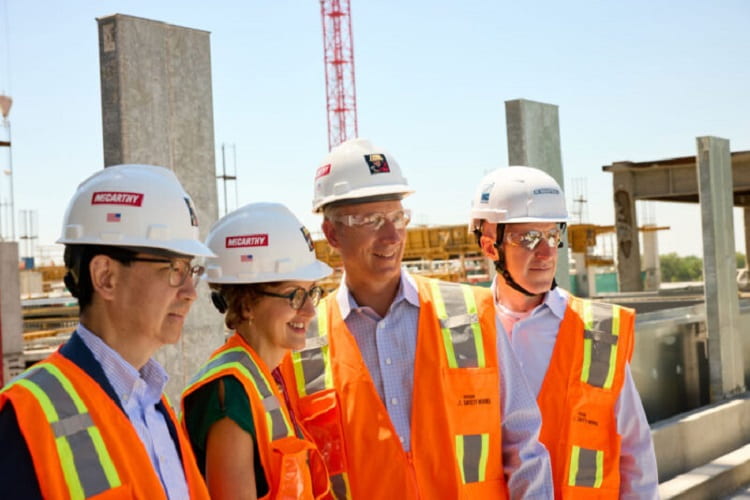Neuroscience leaders and other faculty and staff at Washington University School of Medicine in St. Louis got an up-close look at the Neuroscience Research Building during a recent tour of the construction site.
The framework of all 11 stories has been built, and the process of wrapping the building in glass is underway. On the day of the tour, workers used giant suction cups to carefully swing 12-foot-high sheets of glass into place. The $616 million construction project is expected to be completed in August 2023.
The tour began in the basement, and its curious participants climbed the stairs up to what will become the entrance lobby — now a vast, dusty, high-ceilinged space. When the building is finished, the lobby will stretch three stories high and the length of the building, and be encased in glass.
“What’s most impressive is the sheer scale of the building,” said David Holtzman, MD, the Barbara Burton and Reuben M. Morriss III Distinguished Professor of Neurology and director of the Hope Center for Neurological Disorders, which will be moving en masse into the new building. “I’ve seen the plans, but I didn’t really have a sense of what it looks like until I was able to see it in person.”
Key areas on each floor have been blocked out, and the process of outfitting them for specific purposes has begun. Collaborative work areas dominate the center of each floor. Researchers from multiple labs will perform experiments side-by-side in such work areas, a setup designed to maximize cross-lab communication and collaboration. Smaller rooms with shared equipment for specialized scientific techniques encircle the central research areas on each floor. Offices and desk spaces rim the edges of the building, providing views of the rest of the Washington University Medical Campus and the neighboring Cortex Innovation Community. On the third floor, a rooftop terrace that one day will be home to a coffee shop and outdoor seating is beginning to take shape.
Along with Holtzman, the group included the heads of three of the five main neuroscience-related departments — Jin-Moo Lee, MD, PhD, the Andrew B. and Gretchen P. Jones Professor and head of the Department of Neurology; Linda J. Richards, PhD, the Edison Professor of Neurobiology and head of the Department of Neuroscience; and Gregory J. Zipfel, MD, the Ralph G. Dacey Distinguished Professor and head of the Department of Neurological Surgery, and neurosurgeon-in-chief at Barnes-Jewish Hospital.
See here for more information on the construction of the Neuroscience Research Building.
